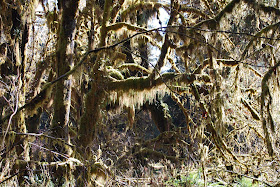 The road to the Hoh Rainforest winds through the wet, moss-coated forests, giving a inkling of the wilder things to come...
The road to the Hoh Rainforest winds through the wet, moss-coated forests, giving a inkling of the wilder things to come...A never-ending sound of water: dropping, drizzling and splashing everywhere. And a smell of drenched, soaked earth, combined with the aromatic fragrance of water-dripping conifers. The Olympic National Park in western Washington state might seem like an odd holiday destination for winter weary Seattleites being a place four times wetter than our drizzly hometown, but it is nevertheless the place where we spend our spring break, hiking the forests and beachcombing the shores of the Pacific ocean.
*
 Waterfalls run through the soaked slopes of the mountains.
Waterfalls run through the soaked slopes of the mountains.*
On these western slopes of the Olympic mountains, the storms from the ocean drop off their wet cargo drenching the area with up to 170 inches (almost 4 meters) of rain per year and creating perfect growing conditions for fertile temperate rainforests. Once, they covered the land between Oregon and southern Alaska, but today, only the lush valleys of Hoh, Queets, Quinault and Bocachiel protected within the National Park remain as a testament for how the landscape looked like before logging took over. In the tiny town of Forks near the Hoh Rainforest, there was no escaping from commercial buzz created by the "Twilight" vampire sagas, but for once this felt like a stroke of luck, as the place (the village, not the surrounding nature...) seemed to need all the help it can get to be any kind of a magnet for visitors.
* Mossy trees and ferny banks by the shallow, stony Quinault river.
Mossy trees and ferny banks by the shallow, stony Quinault river. *
Walking through the Hoh and Quinault Rainforests, the landscape felt spellbound and almost unreal in its magnificent, great wildness. Everything was dripping, drenched, saturated with water, and all things growing seemed to be involved in a slow but ceaseless competition for light and space. The ground was filled with older generations of giant trees, now gently nursing the younger ones with nutrients from their gradually decaying huge trunks. An earthy, rich smell of decomposing wood lingered in the air, competing with the fragrant scent of the conifers. With their canopies almost 300 feet above, the great, straight stems of Western redcedars, hemlocks and Sitka spruces formed a cathedral with only two colours, emerald and rust, in its stained-glass windows.
*


Beard mosses hanging form the old sugar maples.
*
A thick coat of mosses and lichens clung to every surface. These usually humble background players seemed almost have taken over the scene, celebrating their triumph by forming intricate tapestries in olive and coppery tones, hanging like wet rags from the branches and covering everything on the ground with billowy mounds. Burrowed in these moist cushions, small seeds had germinated and peeked up their heads, ready to begin their long journey upwards guided by the thin threads of light peeking through the greenery from the distant sky.
 The bright leaves of common wood sorrel carpeted the ground together with mosses everywhere.
The bright leaves of common wood sorrel carpeted the ground together with mosses everywhere.Even the river bottom was covered with bright green mosses, swaying gently in the cold, glazier-fed water. Careless of our excited glances, a flock of deer grazed on the adjacent meadow, only interested in the fresh new shoots that poke up from the waterlogged soil.

Tiny spruce saplings sprouting from the fallen trees.
In the evenings, we huddled around the fireplace in our room at the lodge. Listening to the pounding waves outside the windows, we thought of another favorite hiking place of ours on the other side of the same ocean: the Otway National Park with its temperate rainforests of tree ferns, gumtrees and tiny frogs in southeastern Australia. So different, and still so similar. Contented with our visit to these stormy, mossy shores, we couldn't help sending our longing regards with the waves to the gentle, southern sister of these wild northern forests.

Jag har sagt det förut - din blick för mossa är så inspirerande! Här är det mes algea som gäller...:)
ReplyDelete